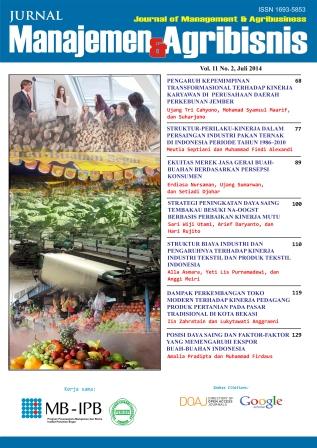STRUKTUR PERILAKU KINERJA DALAM PERSAINGAN INDUSTRI PAKAN TERNAK DI INDONESIA PERIODE TAHUN 1986–2010
Abstract
The purpose of this study were to analyze the structure-Conduct-Performance (SCP) of feed industry in Indonesia during period 1986–2010, and analyze the relationship between the structure and other factors to the performance of the animal feed industry in Indonesia during 1986-2010. This research used descriptive method and quantitative method. The descriptive method was used to analyze the behavior of fodder industry in Indonesia. The quantitative method used to analyze structure and performance of fodder industry with the SCP approach, while for the analysis of factors affecting the performances, OLS (Ordinary Least Square) approach was used. The data use the annual time series data from 1986 to 2010. Based on estimation result, the significant variable to the PCM were X-eff, Growth and MES. Meanwhile, CR4 variable was not significant to PCM.
Keywords: feed industry, OLS, fodder, SCP
ABSTRAK
Tujuan penelitian ini adalah menganalisis Structure Conduct Performance (SCP) industri pakan ternak di Indonesia pada periode tahun 1986–2010 dan menganalisis hubungan antara struktur dan faktor lainnya dengan kinerja pada industri pakan ternak di Indonesia pada periode tahun 1986–2010. Penelitian ini dilakukan menggunakan metode deskriptif dan metode kuantitatif. Metode deskriptif digunakan untuk menganalisis perilaku industri pakan ternak di Indonesia. Metode kuantitatif digunakan untuk menganalisis struktur dan kinerja industri pakan ternak dengan pendekatan SCP, sementara untuk menganalisis faktor-faktor yang memengaruhi kinerja digunakan pendekatan OLS (Ordinary Least Square). Data yang digunakan adalah data time series tahunan dari tahun 1986–2010. Hasil estimasi, variabel yang berpengaruh nyata terhadap Price Cost Margin (PCM) adalah X-eff, Growth, dan Minimum Efficiency Scale. Di sisi lain, variabel CR4 tidak berpengaruh nyata terhadap PCM.
Kata kunci: industri pakan, OLS, pakan ternak, price cost margin (PCM), SCP
Keywords: feed industry, OLS, fodder, SCP
ABSTRAK
Tujuan penelitian ini adalah menganalisis Structure Conduct Performance (SCP) industri pakan ternak di Indonesia pada periode tahun 1986–2010 dan menganalisis hubungan antara struktur dan faktor lainnya dengan kinerja pada industri pakan ternak di Indonesia pada periode tahun 1986–2010. Penelitian ini dilakukan menggunakan metode deskriptif dan metode kuantitatif. Metode deskriptif digunakan untuk menganalisis perilaku industri pakan ternak di Indonesia. Metode kuantitatif digunakan untuk menganalisis struktur dan kinerja industri pakan ternak dengan pendekatan SCP, sementara untuk menganalisis faktor-faktor yang memengaruhi kinerja digunakan pendekatan OLS (Ordinary Least Square). Data yang digunakan adalah data time series tahunan dari tahun 1986–2010. Hasil estimasi, variabel yang berpengaruh nyata terhadap Price Cost Margin (PCM) adalah X-eff, Growth, dan Minimum Efficiency Scale. Di sisi lain, variabel CR4 tidak berpengaruh nyata terhadap PCM.
Kata kunci: industri pakan, OLS, pakan ternak, price cost margin (PCM), SCP
Authors
SeptianiM., & AlexandiM. F. (2015). STRUKTUR PERILAKU KINERJA DALAM PERSAINGAN INDUSTRI PAKAN TERNAK DI INDONESIA PERIODE TAHUN 1986–2010. Jurnal Manajemen & Agribisnis, 11(2), 77-88. https://doi.org/10.17358/jma.11.2.77-88
Authors who publish with this journal agree to the following terms:
- Authors retain copyright and grant the journal right of first publication with the work simultaneously licensed under a Creative Commons Attribution License that allows others to share the work with an acknowledgement of the work's authorship and initial publication in this journal.
- Authors are able to enter into separate, additional contractual arrangements for the non-exclusive distribution of the journal's published version of the work (e.g., post it to an institutional repository or publish it in a book), with an acknowledgement of its initial publication in this journal.
- Authors are permitted and encouraged to post their work online (e.g., in institutional repositories or on their website) prior to and during the submission process, as it can lead to productive exchanges, as well as earlier and greater citation of published work (See The Effect of Open Access).

